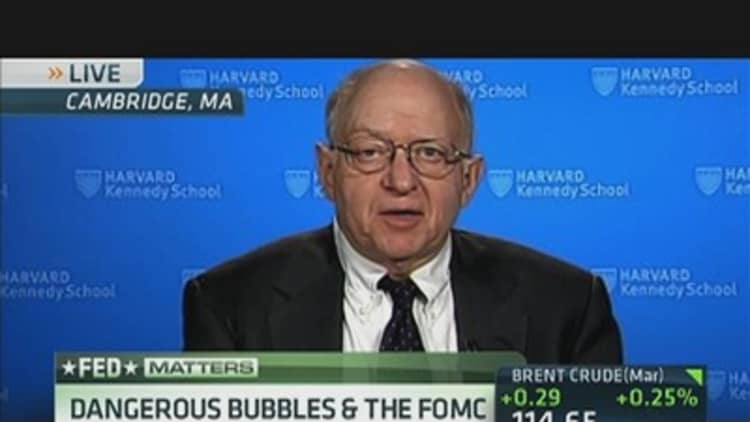
Negative economic growth in the fourth quarter provided a scary headline to start Wednesday's trading but probably little else in market impact.
In the best light, the headline drop of 0.1 percent in gross domestic product masked stronger internals regarding consumer and business spending as well as progress in the housing recovery. (Read More: GDP Shows Surprise Drop for US in Fourth Quarter)
At its worst, the bad news merely provides more cover for a Federal Reserve intent on churning out stimulus until it determines the economy can survive on its own.
"I don't think this negative number is going to have much legs," said Jim Paulsen, chief market strategist at Wells Capital Management in Minneapolis.
The darker scenario, in fact, is actually bullish for stocks, which have ridden the wave of $3 trillion in central bank liquidity to eclipse five-year highs and push towards a new record.
Fed Chairman Ben Bernanke "has to keep the economy high as a kite. He has to make sure we don't sober up and realize how screwed up we are," said Peter Schiff, founder and CEO at Euro Pacific Capital in New York. "We don't have a real recovery. It's an illusion, it's a drug-induced high. The minute you take away the drugs we come down. We can't stop easing, ever." (Watch: Why Doesn't Fed Ease Off Stimulus?)
Schiff is concerned that a recession looms that will dwarf the financial crisis woes, a condition he attributes to an overzealous Fed that should stop creating money and generating inflation.
"The next recession we go into will be even worse than the one we came out of," he said. "We didn't do anything right."
The Fed's Open Markets Committee concluded its meeting Wednesday with a statement that the central bank would continue its $85 billion a month bond-buying program and its zero interest rate policy.
That policy is likely to persist even though the GDP report contained some undeniably bright news.
Consumer spending rose 2.2 percent and savings grew to 4.7 percent from 2.6 percent in the previous quarter. Residential construction surged 15.3 percent, leading housing to be a plus for GDP for the first time in nearly eight years. (Read More: Pending Home Sales Fall Due to Dwindling Supply)
"Consumption rose by 1.5 percent and was higher than 1.1 percent in (the) previous quarter," said Andrew Wilkson, chief economic strategist at Miller Tabak in New York. "This is the biggest clue to counter accusations that the economy is slowing down."
This despite expectations that growth would slow due to the turmoil of the fiscal cliff drama in Washington and overhang from October's devastating Superstorm Sandy.
"If anything you've got to feel pretty good that the private sector was close to 3 percent despite Sandy," Paulsen said. "You've got to be impressed with the equipment spending, software spending, residential spending, big-ticket, autos, consumption - overall, there are just some good parts of this thing."
In fact, the decline in growth was attributable mostly to sharp cutbacks in government spending and business inventories. Otherwise, GDP would have grown 2.6 percent, according to Paul Ashworth, chief U.S. economist at Capital Economics.
"First-quarter GDP growth is going to be pretty weak because of the expiry of the payroll tax cut, but there is nothing in this report to change our view that growth will accelerate as this year goes on," Ashworth said in a note. "This is the best looking contraction in GDP you'll ever see."
Stocks took a mild dip in early Wednesday trading, but unless the fourth-quarter negative reading is confirmed both in subsequent revisions and followed up with a negative first-quarter, which would equate to a recession, the market is unlikely to take much notice.
"If this really was the start of a new recession, like the ones in 2001 and 2008, then we would expect to see GDP excluding defense and inventories falling, too," Ashworth said. "Instead, the growth rate is accelerating."
Paulsen said Friday's nonfarm payrolls report is likely to impact the market more. Economists expect a net of 166,000 new jobs for January and a steady unemployment rate of 7.8 percent.
"You're staring down the barrel of what really matters in two days," he said. "This (GDP) thing is going to be long forgotten."


